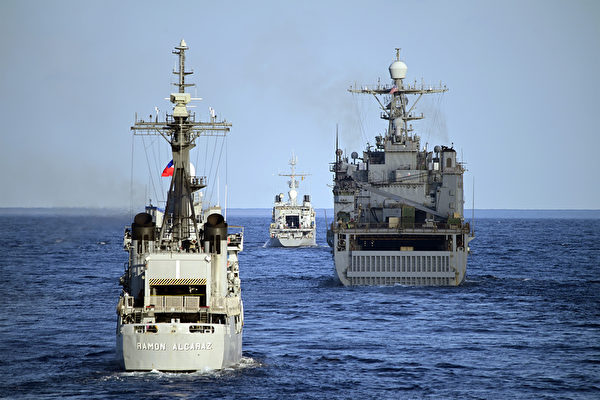In late April, the Philippines and the United States conducted joint military exercises named “Balikatan” in the disputed islands and reefs of the South China Sea for the first time. Shortly after, Chinese coast guard vessels sprayed powerful water cannons at Philippine coast guard and fisheries vessels in the South China Sea, further escalating tensions in the region.
The Philippines and the United States are currently engaged in a three-week-long “Balikatan” exercise, involving over 16,800 military personnel from the US, the Philippines, and Australia, with the participation of a French navy patrol ship, making it the largest exercise in years.
The exercise director of “Balikatan,” Michael Logico, posted on Facebook yesterday (May 1) that the Philippine Air Force’s light transport plane, NC212i, recently conducted an airdrop mission to deliver supplies to Patag Island, also known as Fee Saxon Island, marking the first time such activity has taken place in the South China Sea’s Kalayaan Island Group.
The Kalayaan Island Group is an administrative region set up by the Philippines in the disputed islands of the Spratly archipelago. The Philippines currently controls Fee Saxon Island, while Taiwan, China, and Vietnam all claim sovereignty over it.
The Philippine Armed Forces stated that the NC212i transport plane was used to deliver essential supplies such as food and medication to government troops deployed on remote islands.
They highlighted the successful aerial resupply exercise on Fee Saxon Island undertaken by the Philippine Air Force on April 27, emphasizing their commitment to providing support to troops stationed in the West Philippine Sea and maintaining their readiness, which boosts morale and contributes to regional security and stability.
The West Philippine Sea is the region where the Philippines asserts its sovereignty in the South China Sea, roughly covering the country’s 200-nautical-mile exclusive economic zone.
Since early last year, Chinese coast guard vessels have repeatedly used high-pressure water cannons to obstruct Philippine supply ships from reaching Ayungin Shoal in the South China Sea to deliver goods to the stranded Philippine troops aboard a grounded vessel. Manila intentionally grounded a World War II-era ship at Ayungin Shoal in 1999 and stationed troops there to maintain effective control, necessitating regular supply deliveries and troop rotations.
As the supply shipments continue to face obstacles, airdropping supplies to the stranded vessel became one of the options for the Philippine military.
However, Manila accused a Philippine coast guard vessel and a fisheries and aquatic resources bureau vessel of being damaged by powerful water cannon blasts from Chinese coast guard vessels near the Chinese-controlled Mischief Reef on April 30.
While Logico claimed that the airdrop exercise on Fee Saxon Island was part of the US-Philippine “Balikatan” exercises, the Philippine military statement clarified that it was a unilateral activity by the Philippines, and that the trilateral maritime exercises conducted among the US, Philippines, and France from April 27 to 29 in the South China Sea did not include the airdrop exercise by the US and France.
With tensions running high in the South China Sea, the trilateral maritime exercises involving the US, the Philippines, and France included activities such as maritime search and rescue, shooting exercises, replenishment at sea (RAS), casualty evacuation (CASEVAC), medical evacuation (MEDEVAC), and cross-deck exercises.
The Philippines and the French navy deployed an AgustaWestland AW109 helicopter and a Frelon FH160 helicopter respectively to enhance their cooperative combat capabilities during the exercises.

